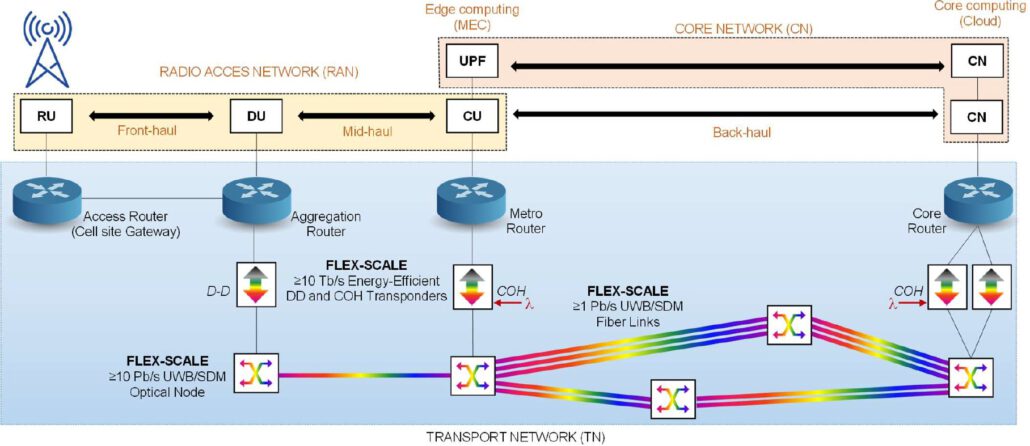FLEX-SCALE: Flexible Scalable Energy Efficient Networking
About Project FLEX-SCALE:
Tele- and data communications networks are perpetually challenged by emerging bandwidth-intensive applications. The increasing number of such applications has resulted in a substantial surge in total traffic originating from access networks, with a growth rate surpassing 50% compound annual growth rate. Hence there is an imperative demand for these networks to achieve higher data rates, lower latency, and increased capacity. Fiber access networks must reach smaller, denser, and more numerous cell sites while ensuring higher capacity, a smaller footprint, faster reconfigurability, lower power consumption, and enhanced reliability to fulfil 6G specifications. While existing technologies can provide partial support for scaling current 5G networks in the short to medium term, new approaches are necessary for the long-term requirements. FLEX-SCALE presents a promising solution for future optical networks by developing:
- A novel Multi-Granular Optical Node (MG-ON) that converges both Ultra-Wide-Band Spectral and Spatial Lanes Multiplexing (UWB/SDM) and is capable of wave-band level switching with a novel Wave-Band Selective Switch (WBSS).
- Energy efficient networking, by replacing/bypassing costly electronic processing systems with plasmonic-based optical Digital-to-Optical converters (oDAC).
- Autonomous Machine Learning (ML)-enabled Software-Defined Networking (SDN) control plane approaches that optimize traffic flow routing across network layers and segments, improving the network’s Quality of Service (QoS).
These innovations will enable the scaling of optoelectronic interfaces to ≥10 Tb/s, expand the network link capacity to ≥1 Pb/s by UWB/SDM, increase ON capacities to ~tens Pb/s with flexibility to lower costs and energy consumption, and implement an efficient and dynamic allocation of resources across the 6G network. These developments simultaneously expand the capabilities of tele- and datacom networks while simultaneously making more efficient use of them. Photonic integration lets these devices remain small and lightweight, while consuming considerably less power.
Schematic of the FLEX-SCALE high-capacity, UWB+SDM transport network for 6G.
The Role of LioniX International:
LioniX International is responsible for the fabrication of the Wave-Band Selective Switch (WBSS) on its ultra-low loss silicon nitride platform, TriPleX®. The WBBS TriPleX® chip will feature:
- Adaptive optical lattice filters (with ≥10 taps) for flexible and adaptable band selection and crossbar switches for scalable output port counts (1×19).
- Stress-based piezoelectric (PZT-enabled) phase modulators, operating at few μs and with negligible power consumption.
- Extended wavelength operation from 1460 nm to 1625 nm, covering the S+C+L bands, while also being flexibly configurable to cover a super channel.
Additionally, LioniX International will contribute its expertise in the modular PZT driver controls, and to interface and control architecture analyses to effectively embed the multi-parameter- WBSS into the envisioned testbeds.
The WBSS operating together with enhanced WSS (wavelength selective switches) and OXCs (optical cross-connects) make up the novel SDN controlled MG-ON. The MG-ON will provide the capacities on demand, serving the needs of Aggregation/Metro/Core routers across the front-, mid- and back-haul 6G network segments.
FURTHER INFORMATION:
🌐 Visit the project’s website for a full rundown of its aims and consortium members.
🌐 Stay up to date about the project by following its LinkedIn updates.
🌐 Check out the newsletter of the project.
🌐 Read more about TriPleX® technology and integrated microwave photonics development at LioniX.




